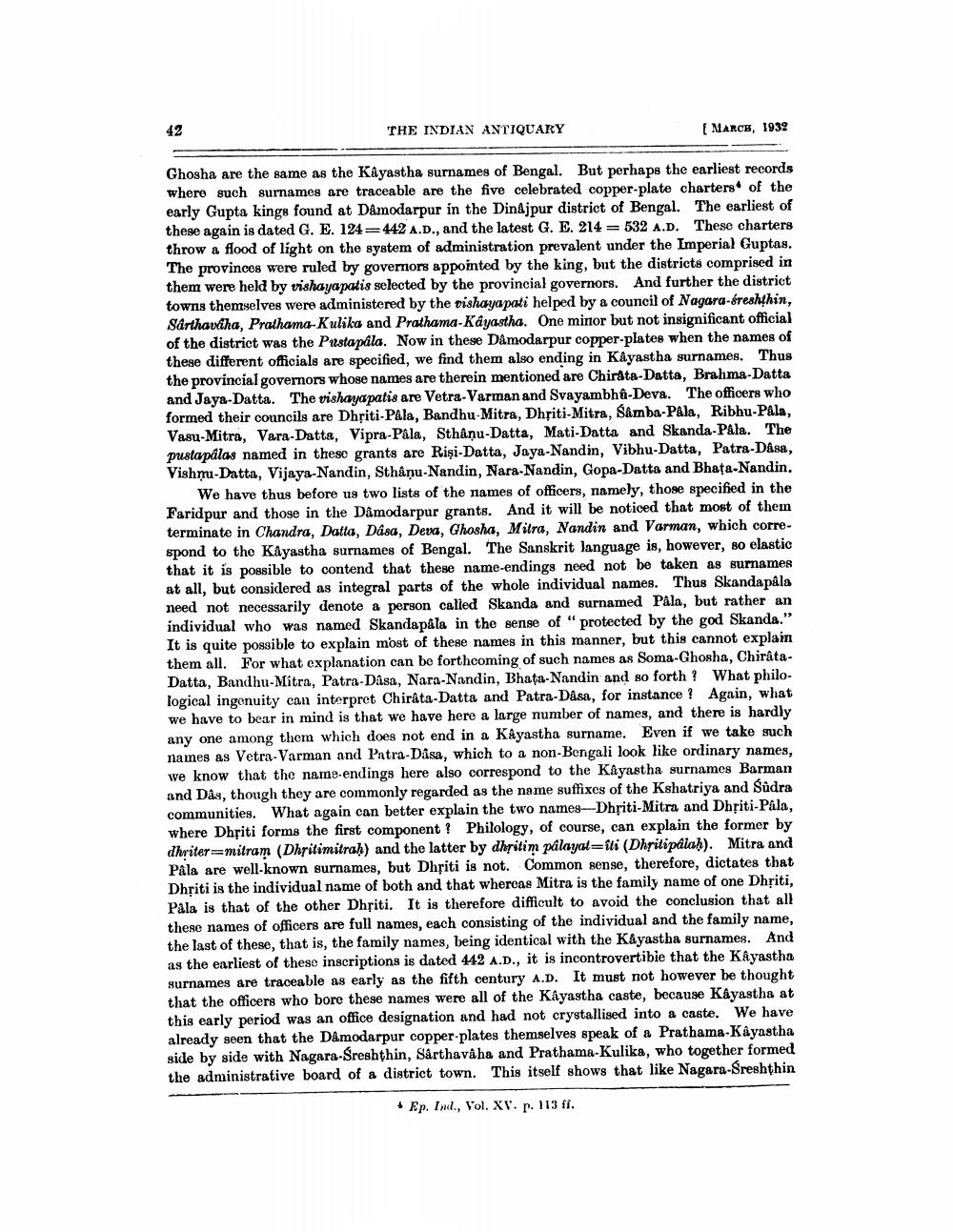________________
42
THE INDIAN ANTIQUARY
MARCE, 1932
Ghosha are the same as the Kayastha surnames of Bengal. But perhaps the earliest records where such surnames are traceable are the five celebrated copper-plate charters of the early Gupta kings found at Damodarpur in the Dinajpur district of Bengal. The earliest of these again is dated G. E. 124=442 A.D., and the latest G. E. 214 = 532 A.D. These charters throw a flood of light on the system of administration prevalent under the Imperial Guptas. The provinces were ruled by governors appointed by the king, but the districts comprised in them were held by vishayapatis selected by the provincial governors. And further the district towns themselves were administered by the vishayapati helped by a council of Nagara-freshthin, Sarthavdiha, Prathama-Kulika and Prathama-Kayastha. One minor but not insignificant official of the district was the Pustapila. Now in these Damodarpur copper-plates when the names of these different officials are specified, we find them also ending in Kayastha surnames. Thus the provincial governors whose names are therein mentioned are Chirata-Datta, Brahma-Datta and Jaya Datta. The vishayapatis are Vetra-Varman and Svayambha-Deva. The officers who formed their councils are Dhriti-Pala, Bandhu-Mitra, Dhriti-Mitra, Samba-Pala, Ribhu-Pala, Vasu-Mitra, Vara-Datta, Vipra-Pala, Sthâņu-Datta, Mati-Datta and Skanda-Pala. The pustapalas named in these grants are Rişi-Datta, Jaya-Nandin, Vibhu-Datta, Patra-Dåsa, Vishņu-Datta, Vijaya-Nandin, Sthâņu-Nandin, Nara-Nandin, Gopa-Datta and Bhata-Nandin.
We have thus before us two lists of the names of officers, namely, those specified in the Faridpur and those in the Damodarpur grants. And it will be noticed that most of them terminate in Chandra, Datta, Dása, Deva, Ghosha, Mitra, Nandin and Varman, which correspond to the Kayastha surnames of Bengal. The Sanskrit language is, however, so elastic that it is possible to contend that these name-endings need not be taken as surnames at all, but considered as integral parts of the whole individual names. Thus Skandapala need not necessarily denote a person called Skanda and surnamed Pala, but rather an individual who was named Skandapala in the sense of "protected by the god Skanda." It is quite possible to explain most of these names in this manner, but this cannot explain them all. For what explanation can be forthcoming of such names as Soma-Ghosha, ChirataDatta, Bandhu-Mitra, Patra-Dasa, Nara-Nandin, Bhata Nandin and so forth? What philological ingenuity can interpret Chirâta-Datta and Patra-Dasa, for instance? Again, what we have to bear in mind is that we have here a large number of names, and there is hardly any one among them which does not end in a Kayastha surname. Even if we take such names as Vetra-Varman and Patra-Dåsa, which to a non-Bengali look like ordinary names, we know that the name endings here also correspond to the Kayastha surnames Barman and Dås, though they are commonly regarded as the name suffixes of the Kshatriya and Südra communities. What again can better explain the two names--Dhriti-Mitra and Dhriti-Pala, where Dhriti forms the first component ? Philology, of course, can explain the former by dhriter=mitram (Dhritimitrah) and the latter by dhritim palayal=iti (Dhritipaiah). Mitra and Pála are well-known surnames, but Dhriti is not. Common sense, therefore, dictates that Dhțiti is the individual name of both and that whereas Mitra is the family name of one Dhriti, Pala is that of the other Dhriti. It is therefore difficult to avoid the conclusion that all these names of officers are full names, each consisting of the individual and the family name, the last of these, that is, the family names, being identical with the Kayastha surnames. And as the earliest of these inscriptions is dated 442 A.D., it is incontrovertible that the Kayastha surnames are traceable as early as the fifth century A.D. It must not however be thought that the officers who bore these names were all of the Kayastha caste, because Kayastha at this early period was an office designation and had not crystallised into a caste. We have already seen that the Damodarpur copper-plates themselves speak of a Prathama-Kayastha side by side with Nagara-Sreshthin, Sårthavâha and Prathama-Kulika, who together formed the administrative board of a district town. This itself shows that like Nagara-Sreshthin
* Ep. Iwl., Vol. XV. r. 113 ff.




